1. Abstract
India is a country known for its diversity. In the diverse fabric of inhabitants, India’s governing policies and laws are meant to safeguard the rights and responsibilities of minor groups residing in India, amidst the general laws for all of her inhabitants. Minor groups like tribes of India, registered in the schedule of tribes, enjoy the privileges that they receive from these laws and legislations. However, these laws have been reasons for many brief uprisings across the country in places with high percentages of tribal inhabitants. This investigation aims at answering the hypothesis of justice delivered to the scheduled tribes of India, in the name of special rights and responsibilities, taking the case study of Manipur, a state in the north-eastern part of India. Manipur being one of the states with high population of tribal inhabitants, has seen conflicts within the tribes and conflicts between tribes and other communities. The conflicts which have primarily revolved around the social status of Scheduled Tribes have become the base of understanding what the law promises and what does the law deliver.
2. Hypothesis
Does India’s scheduled tribe status deliver special privileges and safety from violence to the tribes of India?
3. Methodology

4. Scope
The scope of this investigation is to understand the effects of special rights of the ones receiving it whilst also seeing the effects of the same rights on the ones who are not and how can it be a reason to spark conflicts across communities of India. The reach of the investigation within the timeframe is limited to the state of Manipur, where recent events of conflict between tribes and other communities have created a screenplay of utter distress and chaos. However, the investigation methodology and data points can extrapolated further to investigated similar events in all of India.
5. Case Study: Communities of Manipur
5.1. Indian history and Governance
India got its independence from the British in August of 1947. During British rule India was broadly divided into the British Provinces and the Princely states. The British Provinces were directly ruled by the British officials of the East India Company. The East India Company was the legislative body that decided the governing laws for the British Provinces. On the contrary, Princely States were ruled by the local rulers who acknowledged British sovereignty in return for local autonomy. Hence the governing laws for Princely States were different for different States, as decided by their local rulers. India had a total of 565 princely states.
Once India got its independence, within a period of 3 years (1947-1950), 562 of the Princely States acceded with India after the partition of India into India, East Pakistan (now Bangladesh) and West Pakistan (now Pakistan). The 562 Princely States along with the British Provinces together joined to be the 26 states of India in 1950. Post Independence, the partition of India and emergence of the 26 states changed the legislation of India, as India became a democratic State.

India adopted the federal system of government. In the federal system of governance, the smallest divisions of India are governed by 4 levels of legislation. India is currently divided into 28 states, which is called the provincial level, each of which is divided into districts and further on these districts are divided into several sub-districts. All the broader laws and rights are decided by the center which is at the country level and each of these laws are further diversified at the provincial level depending on various factors central to the specific state.
5.2. Schedule of Tribes
In the constitution of India, schedule is the legal listing of specific communities with the purpose of their upliftment and integration into mainstream society, by providing adequate representation in education and governance. Various tribal residents of India are listed in this schedule and are collectively called the Scheduled Tribes of India.

The Constitution of India broadly declares a framework to govern the Tribal communities mentioned in the Scheduled of Tribes and also outlines their rights and responsibilities. Conversely, the National Commission of Scheduled Tribes(NCST) was written in a more comprehensive method adhering to the framework mentioned in the Constitution of India. Subsequently, the NCST mentions in complete detail the requirements to be registered in the Schedule of Tribes, to protect and safeguard the rights of those who are legitimately minorities in the society amongst the citizens of India. The NCST also States in detail rights of the tribal communities on land, agriculture, mineral resources and others along with their reservations in the different sectors.
5.3. Geographic understanding of Scheduled Tribe rights in Manipur
Manipur, a state in the north-eastern part of India has a very scenic topography spread over an area of 22,327km2. Manipur shares its boundaries with Indian states like Nagaland to the north, Assam to the west, Mizoram to the south and the country of Myanmar to it’s east. The state of Manipur was primarily divided into 9 districts which each had their share of varying topography. Nevertheless, having surrounded by so many states and a country, Manipur’s topography is still one of a kind. Manipur encloses the blue mountains at all of it’s borders, which is at an elevation of 790m above sea level with lush green forests on the elevation. At the centre of the state is the valley which approximately covers an area of 2000km2. 70% of the land within Manipur falls under the rural settlement areas which are situated on the blue mountains and the settlers are called hill people, with the exception of only 30% of the urban area which houses the valley people in the central valleys of the blue mountains.

Most of the forest resources and its cultivation takes place in the lush green mountains of Manipur which are then utilised by the citizens of the state. The mountains are also the area where high mineral resources are found and high mining activities occur to extract minerals like limestone, asbestos, chromite, nickel etc. These mountains are also the lands of high population of Scheduled Tribes who live in very small sub-districts(villages) but reap benefits from the resources available from the land as mentioned in their right in National Commission of Scheduled Tribes.
5.4. Demographic understanding of Manipur
Manipur is a state in the north-eastern part of India with a population of 2,855,794. As per the census of 2011, the demography of Manipur shows that only 30% of the total population lives inside the urban boundaries of Manipur, but a majority of 70% of the population lives in the rural areas in Manipur. The population of Manipur is principally composed of the tribes of Manipur and the Meitei community. The tribes of Manipur refers to a culmination of many tribes that reside in Manipur, few of whom are migrants from other countries and states but are now registered under the Schedule of Tribes as Scheduled tribes.
Manipur is divided into 9 districts with high topographic and demographic diversity. Each district has a diverse community distribution with tribal residents and Meitei residents. These districts also have a diverse distribution in their religious inclination which ranges from Hinduism to Christianity to Islamism and Sanamahism.

6. Investigation: The Burning State of Manipur
The study of the violence and the conflict of Manipur is a complicated task, not only due to the majority of the information being in the form of news articles whose data might not match between each other, but as well because of the blockade on internet service made by the India government at some points of the conflict. A resource that became useful to overcome this difficulty is the Armed Conflict Location & Event Data Project, which provides an openly available dataset that registers reports of conflict and violence events all around the world. The ACLED dataset provides a great amount of information on each event such as: date, disorder type, actors, actor type, associates, interaction type, location, fatalities and sources of report.
6.1. Inciting event of request for status of Scheduled Tribes
In response to the state courts order for the government to consider the meitei inclusion under the status of Schedule tribes, the 3rd of May of 2023, people from the ST communities gathered in a protest organized by the All Tribal Students’ Union of Manipur (ATSUM). The protest started in the district of Churachandpur and it spread throughout the rest of the hills districts, and was named the “Tribal Solidarity March”. On the same day and in response to the march, many counter protests, riots, and instances of mob violence took place throughout the state, concentrated primarily in the Imphal Valley.
6.2. Conflict evolution
Since the start of the conflicts on May 3rd, the state of Manipur has been under constant conflict. The ACLED dataset provides a date for each event, which can be used to visualize the temporality of the conflict and its evolution.
The visualization of this temporality helps to paint a picture that shows the concentration of conflict happens in the middle of 2023, the frequency getting accelerated the 06/2023 and continues up to approximately 09/2023.
6.3. Conflict dimensions
The ACLED conflict event dataset classifies the conflict event based on TYPEs and SUB_TYPEs. This classification helps to filter and understand the different dimensions of the conflict occurring in Manipur. The classifications are as follows:
Battles
A violent interaction between two organized armed groups at a particular time and location. The only SUB_TYPE that the dataset has is Armed Clashed and this is defined as armed organized groups engaging in battle without any change in territorial control.
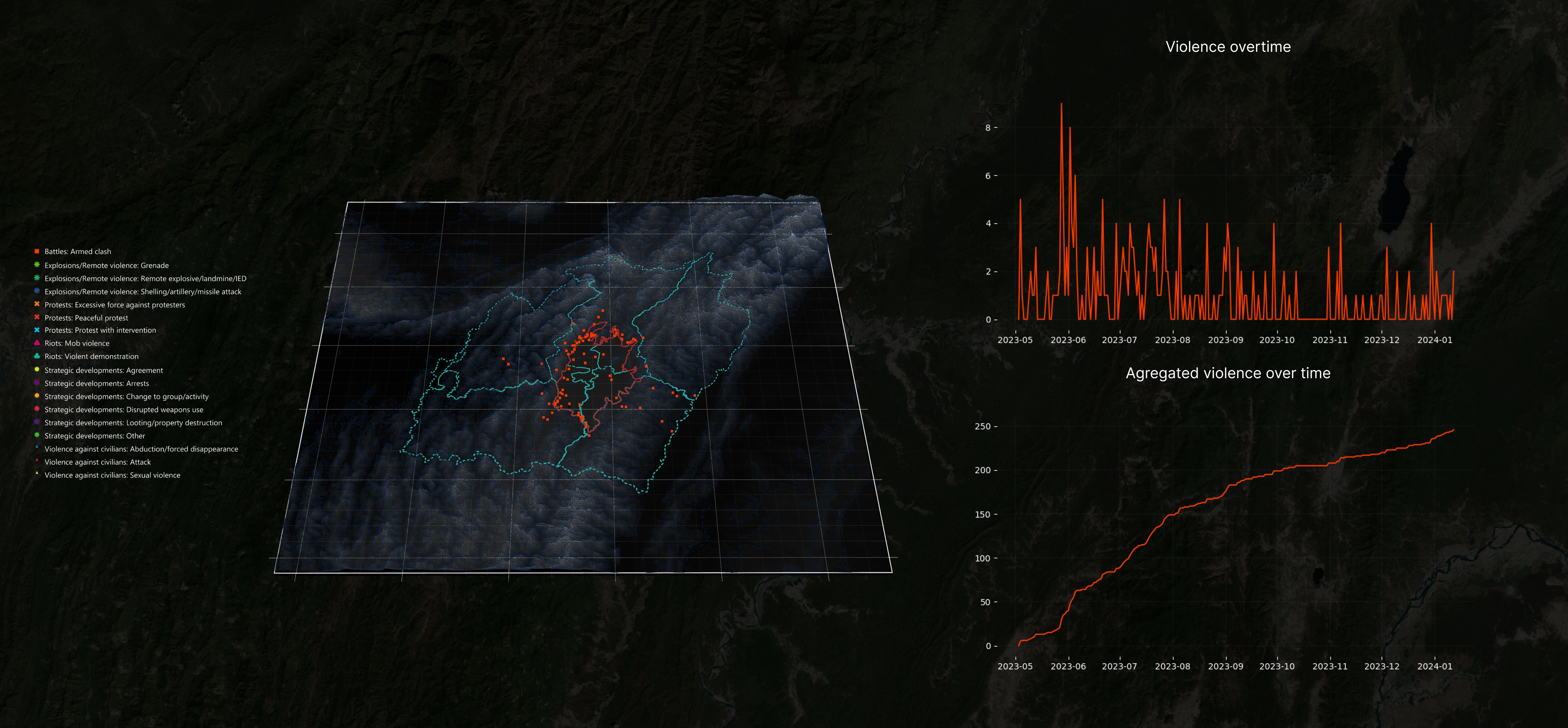
From the datapoint it is visible that this type of conflict is mostly spread throughout the border that separates the hill areas and the valley. Given the nature of the dataset it is not possible to infer which side was the instigator. The evolution of this type of violence is one of the most prominent and constant types in this conflict, based on the frequency it is possible to discern that during the middle of 2023 is when this violence reached its peak.
Protests
An in-person public demonstration of three or more participants in which the participants do not engage in violence, though violence may be used against them. The SUB_TYPEs for these events are Excessive Force Against Protesters, Protest with Intervention, Peaceful Protests.
- Excessive Force Against Protesters: Events where individuals are engaged in a peaceful protest and are targeted with lethal violence or violence resulting in serious injuries.
- Protests with Intervention: Events where individuals are engaged in a peaceful protest during which there is a physical attempt to disperse or suppress the protest without serious/lethal injuries or the targeting of protesters with lethal weapons reported.
- Excessive Force Against Protesters: Events where demonstrators gather for a protest and do not engage in violence or other forms of rioting activity.
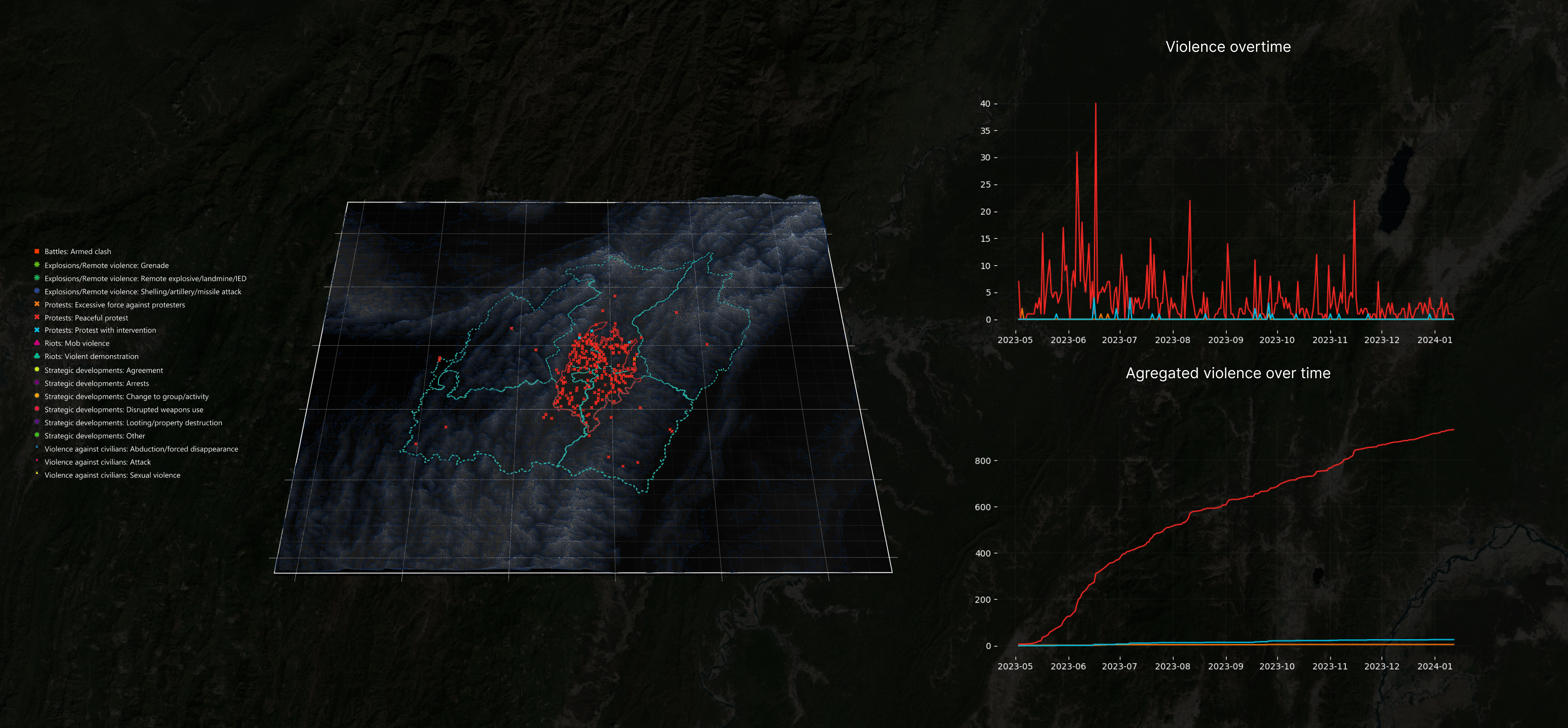
The georeferencing of the ACLED data shows that protests took place all over Manipur. The valley had the most concentration of protests whereas the hills had a lesser amount due to in some part the low density of population in those districts. The data illustrates that even though there were cases of Protests that ended in violence the vast majority were peaceful. Plotting the frequency and amount of the reported protests it is apparent that even though each month has had one or more spikes in protest, the month with the most concentration of protest was June.
Riots
Events where demonstrators or mobs of three or more engage in violent or destructive acts, including but not limited to physical fights, rock throwing, property destruction, etc. The SUB_TYPEs for these events are Violent Demonstration, Protest with Intervention, Peaceful Protests.
- Violent Demonstration: Events where demonstrators engage in violence and/or destructive activity.
- Mob Violence: Events where rioters violently interact with other rioters, civilians or their property, or armed groups outside of demonstration contexts.
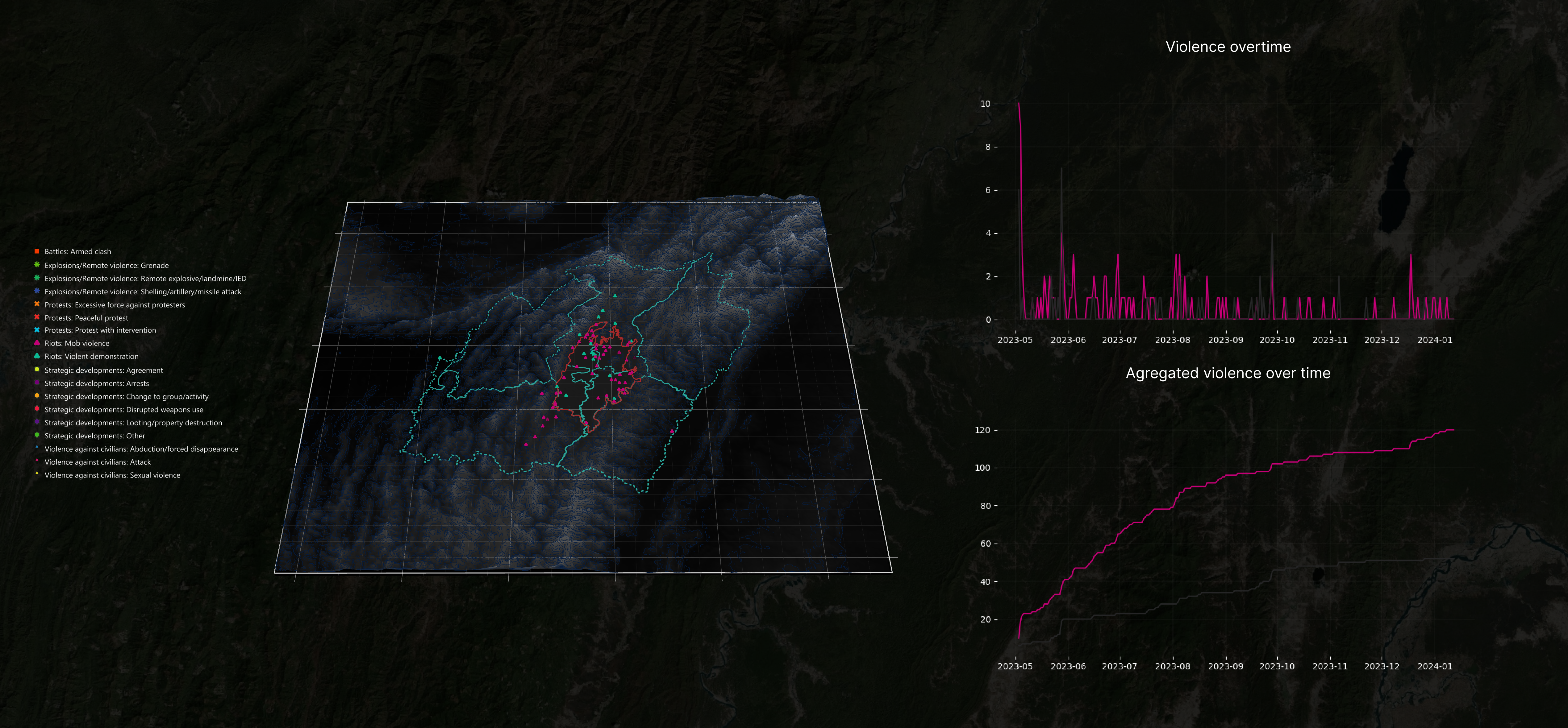
Riots events started, as previously mentioned, as a response to the Tribal March of Solidarity, which was the peak of riots as far as quantity is concerned. After that initial start riots have reduced in numbers but remain pretty consistent in frequency during the totality of the conflict. Looking specifically at the located events it is apparent that these events are almost fully concentrated in the Imphal Valley, as well as the north district of Senapati and south district of Churachandpur. A curious pattern that arises from geolocating the events is that the SUB_TYPE Mob Violence spreads to the north towards Senapati, however the SUB_TYPE Violent Demonstration spreads to the south towards Churachandpur.
Remote Violence
Events in which one side uses weapon types that, by their nature, are at range and widely destructive,including but not limited to: bombs, grenades, improvised explosive devices (IEDs), artillery fire or shelling, missile attacks, air or drone strikes, and other widely destructive heavy weapons or chemical weapons. The SUB_TYPEs for these events are Shelling/Artillery/Missile Attack, Remote Explosive/Landmine/IED, Grenade.
- Shelling/Artillery/Missile attack: Events where there is use of long-range artillery, missile systems, or other heavy weapons platforms in the absence of any other engagement.
- Remote Explosive/Landmine/IED: Events where remotely- or victim-activated devices are detonated in the absence of any other engagement.
- Grenade: Events where a grenade or any other similarly hand-thrown explosive, such as an IED that is thrown, in the absence of any other engagement.
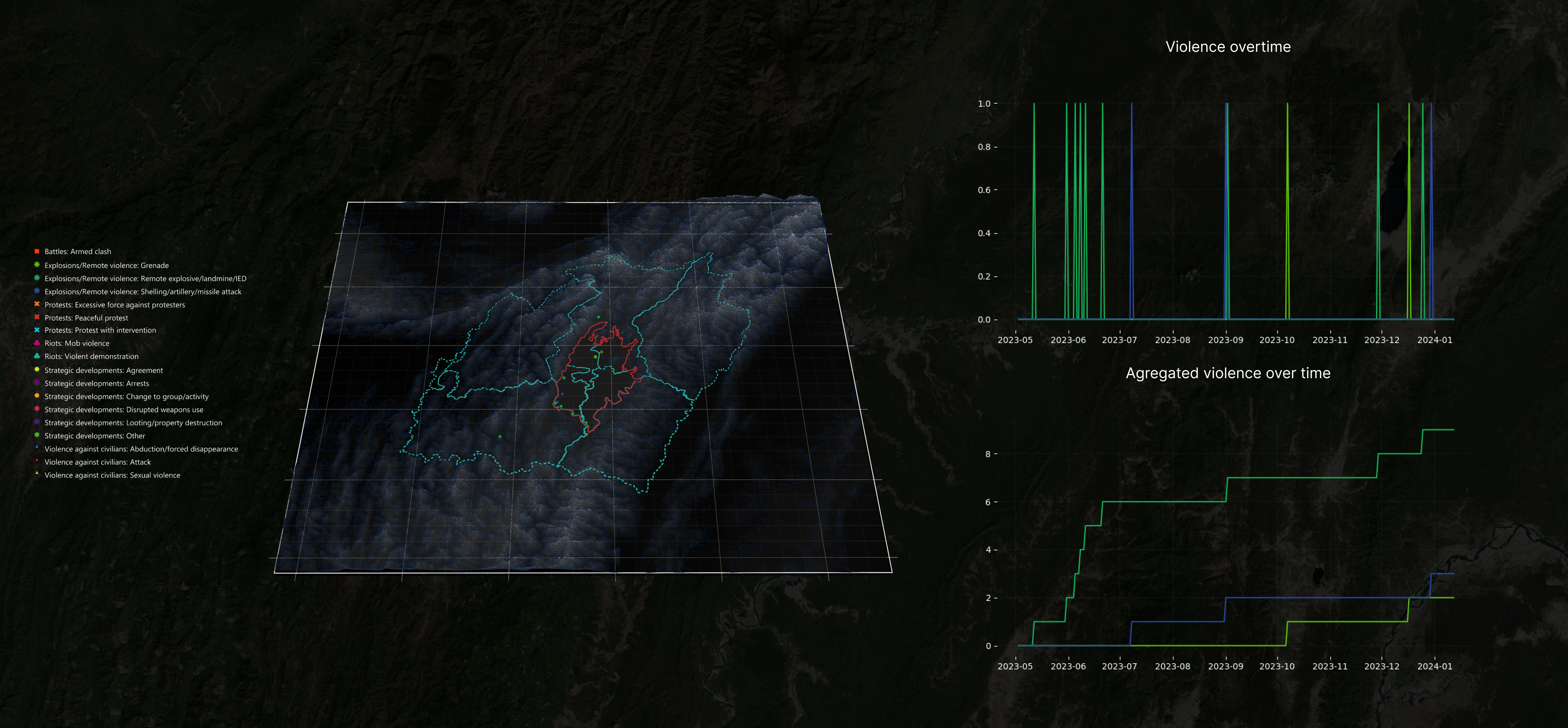
The classification of violent events as Remote Violence is helpful for inferring who is a victim of the violence. Given that Remote Violence necessarily deals with dealing damage to a target that is far from the perpetrator’s place, it’s sensible to assume that the place where the violence took place, or the target, is the place where the victims are. From the plotting of the data points we see that deep in the valley as well as deep in the hills there was a similar amount of events of Remote Violence, meanwhile in the south perimeter that divides both areas the concentration of violence was the highest.
Violence Against Civilians
Events in which an organized armed group inflicts violence upon unarmed non-combatants. The SUB_TYPEs for these events are Attack, Abduction/Forced Dissappearance, Sexual Violence.
- Attack: Events where civilians are targeted with violence by an organized armed actor outside the context of other forms of violence coded higher in the ACLED event type hierarchy.
- Abduction/Forced Disappearance: Events where an actor engages in the abduction or forced disappearance of civilians, without reports of further violence.
- Sexual Violence: Events where any individual is targeted with sexual violence.
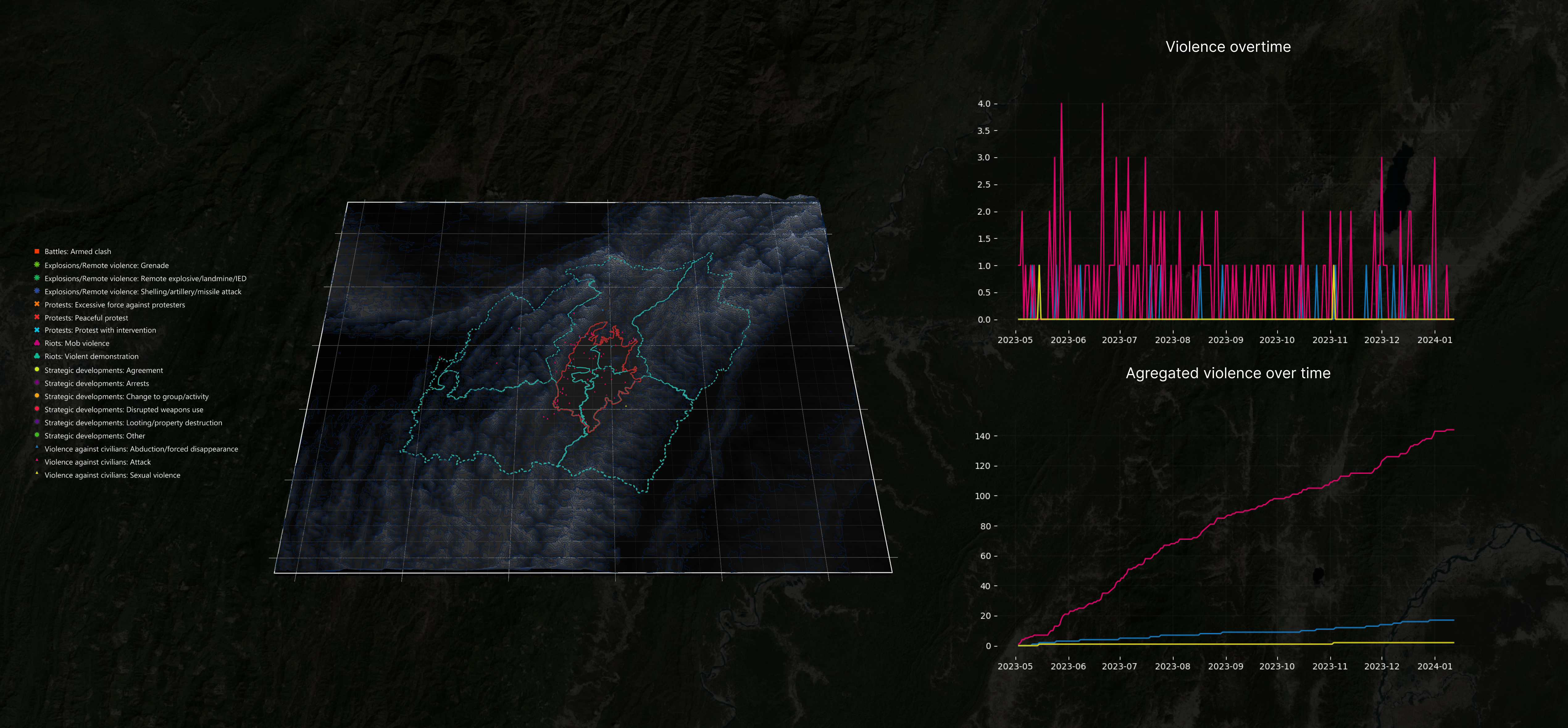
Similarly as with Remote Violence cases, Violence Against Civilians is a classification that lends itself to inferring the victim of the act. The location of the datapoint can be interpreted as the location of the victim, since the victim is considered a civilian, and for that they had to be unaware of the plans of the other actor, and instead had been going about its day. The map shows that the SUB_TYPE Attack is the one with most occurrances, and said occurrences are quite spread throughout the territory, while the other two SUB_TYPEs are less frequent, and in the case of Sexual Violence only appearing on the hills.
Strategic Developments
Events that capture contextually important information regarding incidents and activities of groups that are not recorded as ‘Political violence’ or ‘Demonstrations’ events, yet may trigger future events or contribute to political dynamics within and across states. The SUB_TYPEs for these events are Agreement, Arrests, Change to Group/Activity, Disrupted Weapons Use, Looting/Property Destruction.
- Agreement: Events used to record any sort of agreement between different actors (such as governments and rebel groups).
- Arrests: Events where state forces or other actors exercising de facto control over a territory either detain a particularly significant individual or engage in politically significant mass arrests.
- Change to Group/Activity: Events used to record significant changes in the activity or structure of armed groups.
- Disrupted Weapons Use: Events that capture all instances in which an event of ‘Explosions/Remote violence’ is prevented from occurring, or when armed actors seize significant caches of weapons.
- Looting/Property Destruction: Events where actors engage in looting or seizing goods or property outside the context of other forms of violence or destruction, such as rioting or armed clashes.
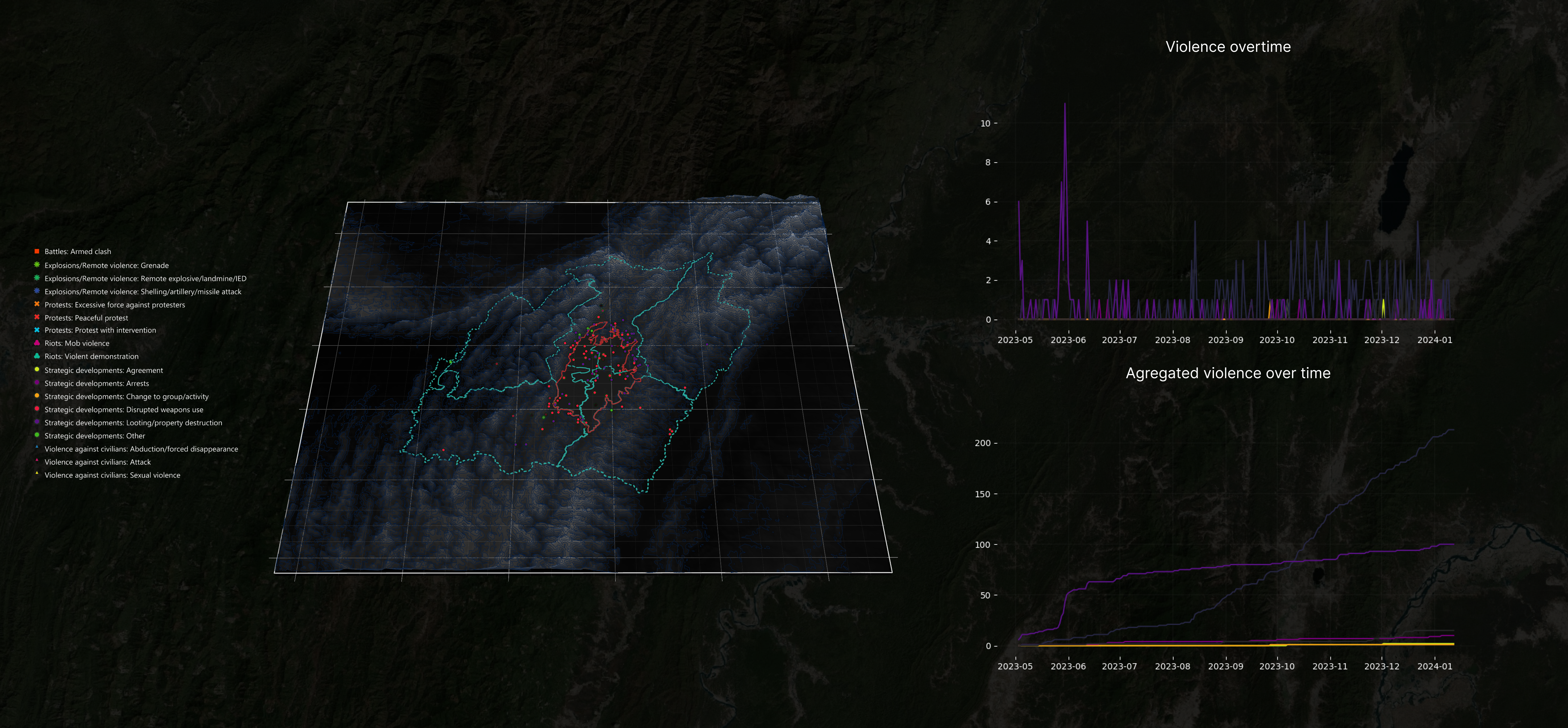
Strategic developments events happened all throughout the state and the two that were the most prominent were Looting/Property Destruction and Disrupted Weapon Use. From these two SUB_TYPEs, Looting/Property Destruction is one that allows us to deduce the victim by the coordinates, since the one affected by the property destruction is the people that live and own those properties. Looking at the accumulated count of this events, as well as the frequency, it’s interesting to point out that the Looting/Property Destruction had a massive peak in June of 2023 and later it the regularity was reduce, whereas Disrupted Weapon Use started becoming prominent (even surpassing Looting/Property Destruction in total cases) after August 2023.
7. Future Developments of Investigation
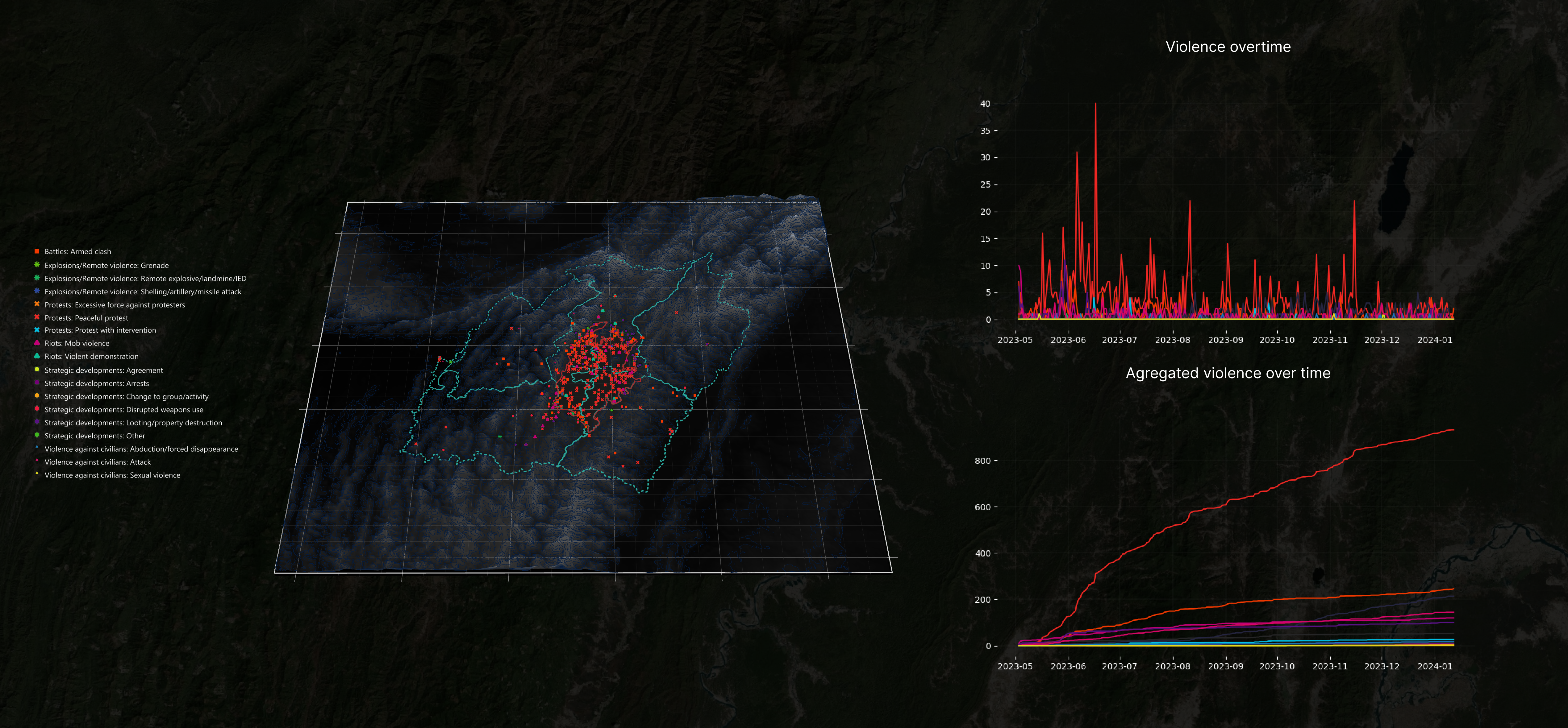
Joining all the dimensions of the conflict together illustrates a macro picture of what happened. The map shows how a great concentration of conflict was located in the Imphal valley and its limits. In addition to he spread of the events, the graphs show that the frequency of conflict has been constant but that June 2023 was the peak in terms of quantity of violence, the graphs also show which kinds of events were the most recurring, being Battles the most occurring type of violence.
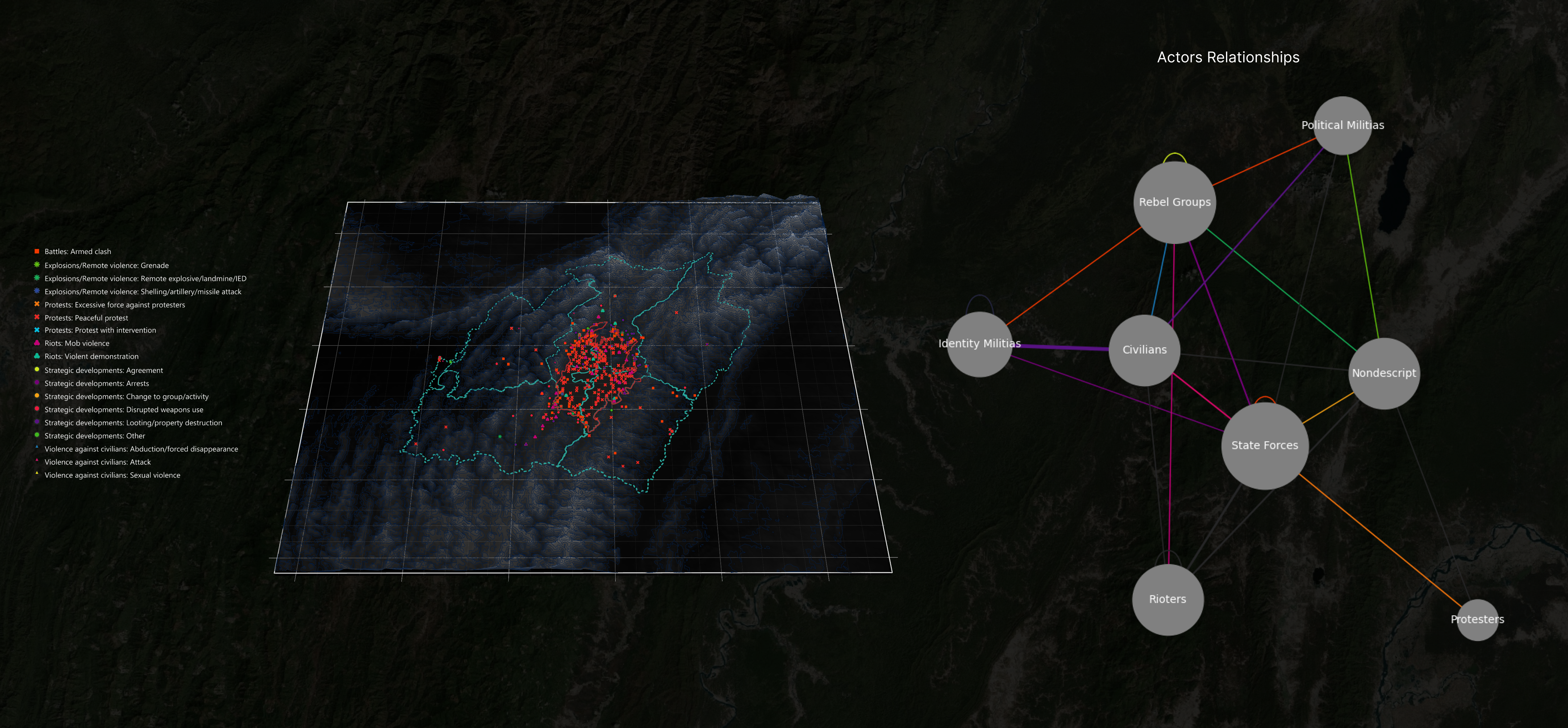
Another way of gaining understanding about the conflict through the ACLED dataset is plotting a node graph of the relations between actors. The data doesn’t specify in any way whether an actor is a perpetrator or a victim, but in some cases that information can be deduced (the Civilians for example will always be at the receiving end of the violence). An issue that arises with the data that ACLED provides is that their definition for what constitutes an actor results in a too granular division of the community making it hard to understand the alliances or opposition each actor might have. Due to this complication a different way of getting a similar insight is to plot the same relation graph but using the actor category, such as: rebel group, government forces, civilians, etc. With said categories a node graph can be constructed where the nodes stand for the type of actor and the edges connecting the show the type of violence committed between them as well as the frequency. Having the violence as a node graph also helps analyze it in new ways, one of those being analyzing the centrality of nodes, where a node being more central in this case can be interpreted as being targeted/or targeting many other nodes. From this centrality analysis, that is reflected in the size of the nodes, it is possible to see that the Civilians are the 3rd most central, below Rebel Groups and State Forces, but in contrast to those two other categories civilian don’t perpetuate the violence they get into but rather are the ones to suffer it, showing that the conflict has had many civilian victims from the rest of the actors.

